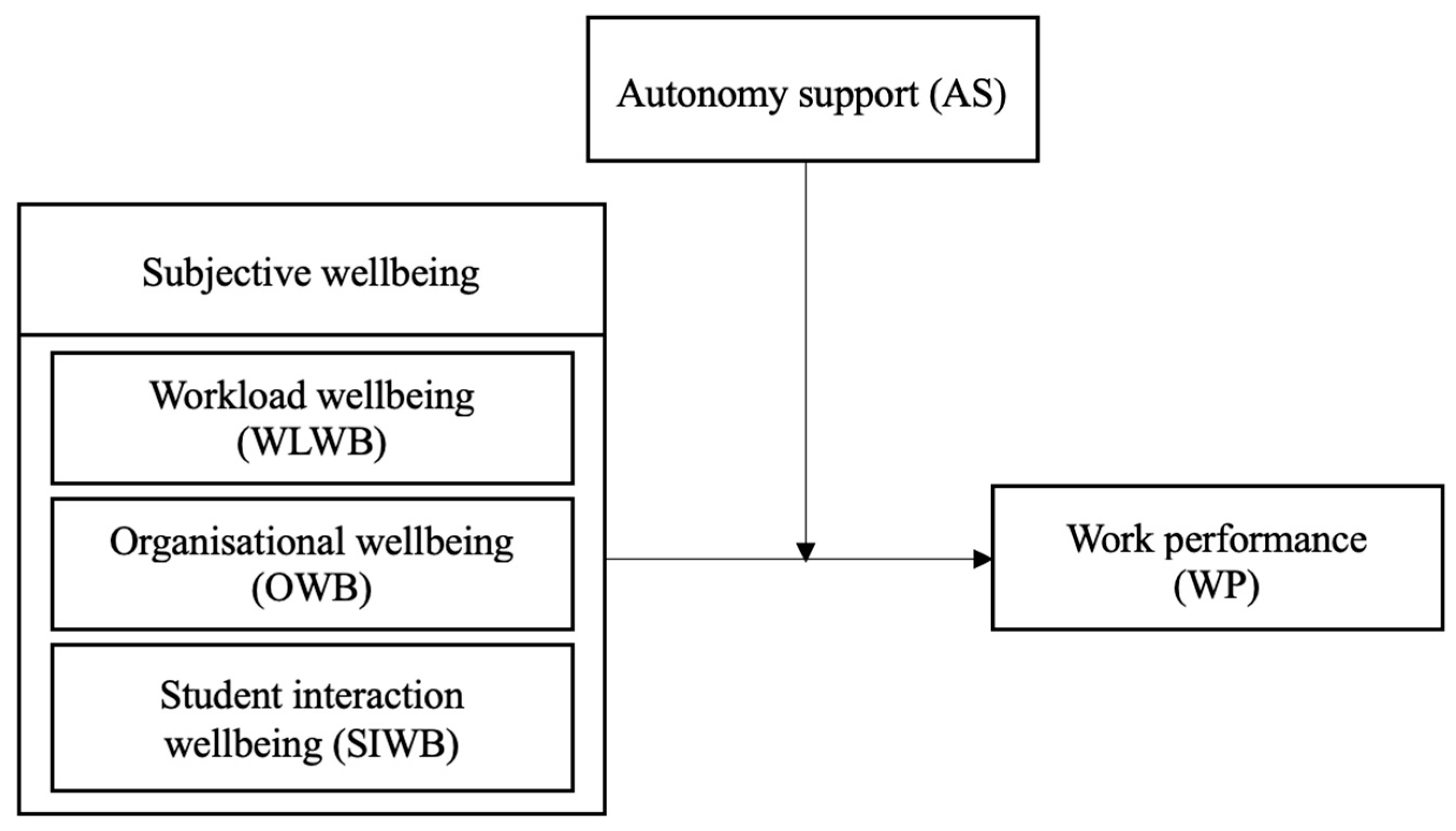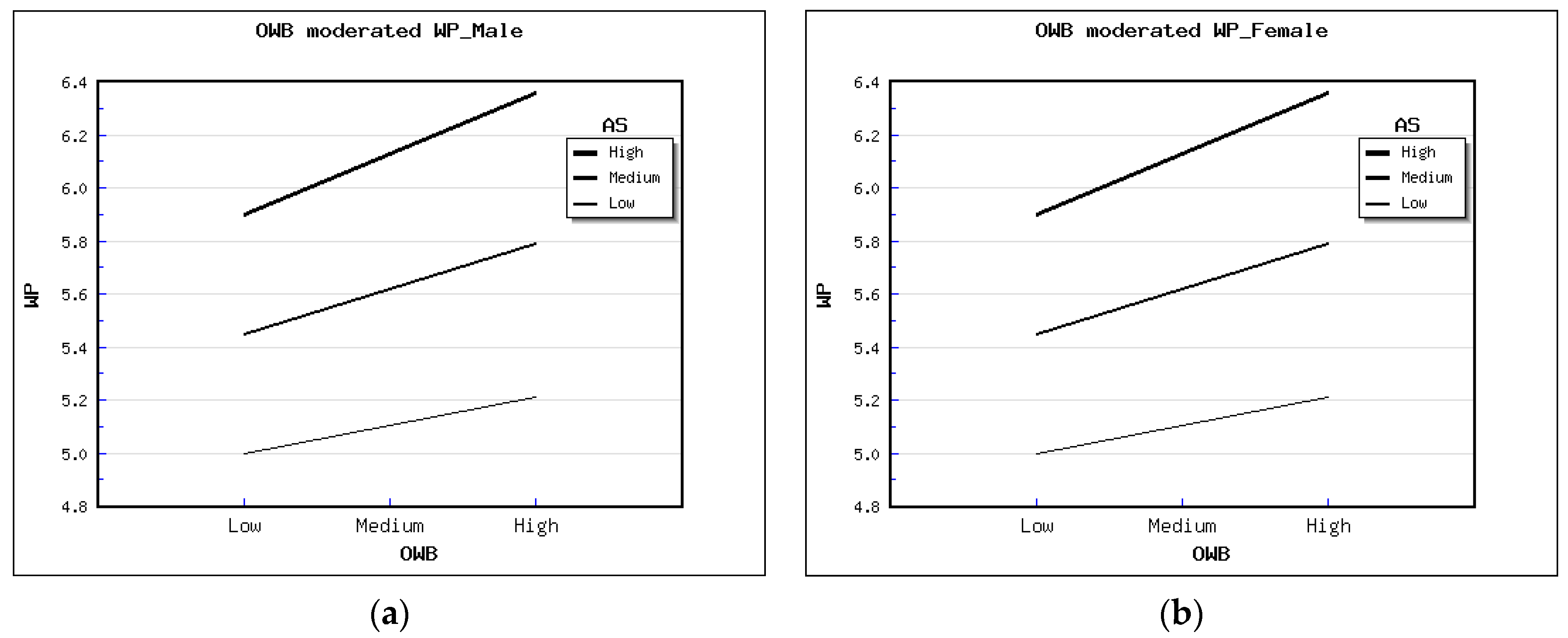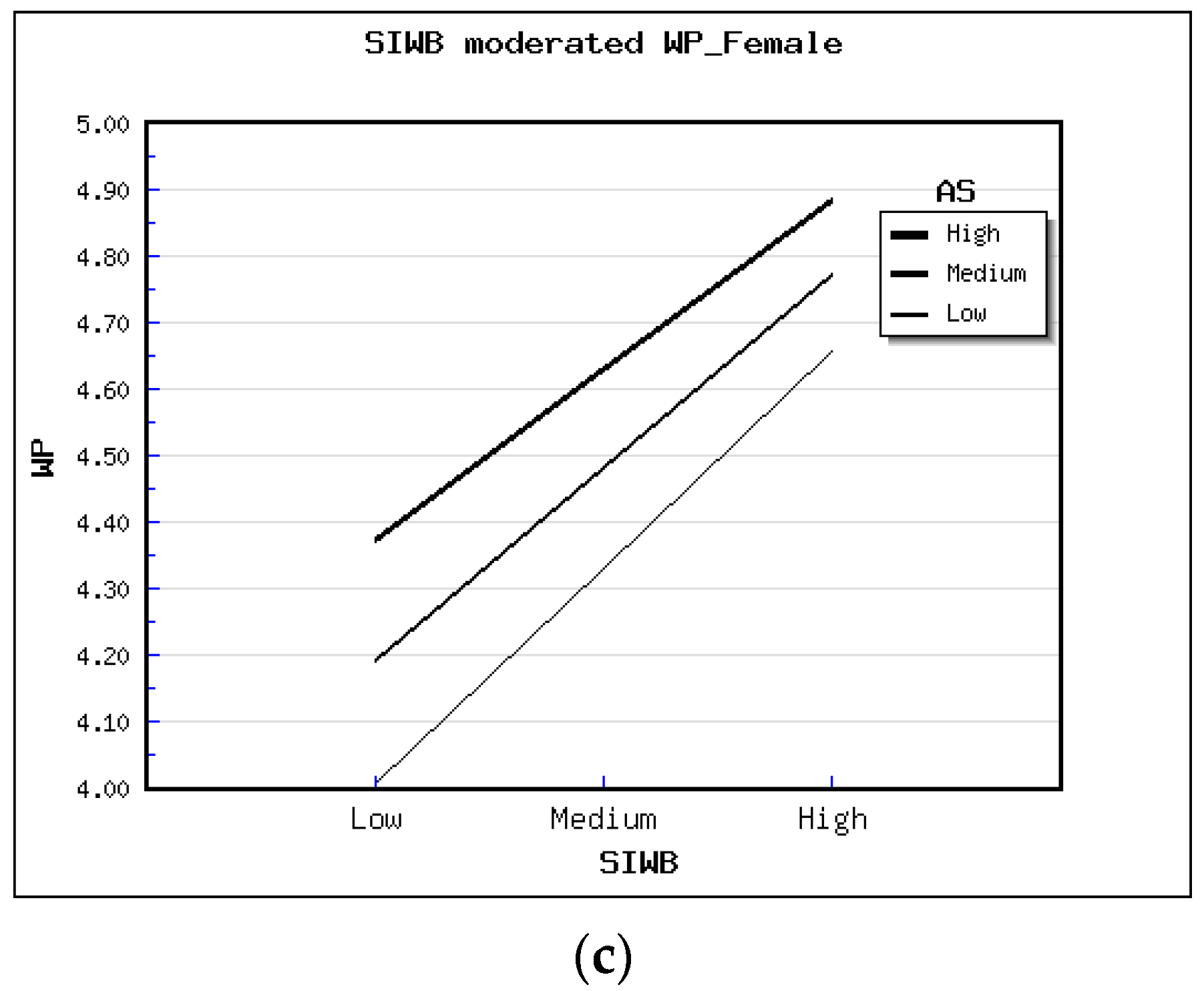Subjective Wellbeing and Work Performance among Teachers in Hong Kong during the COVID-19 Pandemic: Does Autonomy Support Moderate Their Relationship?
Abstract
1. Introduction
1.1. Theoretical Background and Hypotheses
1.1.1. Subjective Wellbeing and Work Performance
1.1.2. Autonomy Support
1.1.3. Moderating Effect of AS
2. Methods
2.1. Study Design and Ethical Consideration
2.2. Measures
2.2.1. Subjective Wellbeing
2.2.2. Work Performance
2.2.3. Autonomy Support
2.3. Data Collection Procedures
2.4. Data Analysis
3. Results
3.1. Characteristics of the Sample
3.2. Preliminary Analyses
3.3. Test of Hypotheses
4. Discussion
4.1. Implications
4.2. Future Research Directions
4.3. Limitations
5. Conclusions
Author Contributions
Funding
Institutional Review Board Statement
Informed Consent Statement
Data Availability Statement
Acknowledgments
Conflicts of Interest
References
- Guzzo, T.; Boffo, S.; Ferri, F.; Gagliardi, F.; Grifoni, P. Towards quality digital learning: Lessons learned during COVID-19 and recommended actions—The teachers’ perspective. Sustainability 2022, 14, 8438. [Google Scholar] [CrossRef]
- Yu, H.-H.; Hu, R.-P.; Chen, M.-L. Global Pandemic Prevention Continual Learning—Taking Online Learning as an Example: The Relevance of Self-Regulation, Mind-Unwandered, and Online Learning Ineffectiveness. Sustainability 2022, 14, 6571. [Google Scholar] [CrossRef]
- HKSAR. Internet Devices at Home for Students from Grass-Roots families [Press Release]. 2020. Available online: https://www.info.gov.hk/gia/general/202011/18/P2020111800334.htm (accessed on 6 April 2021).
- Cotton, P.; Hart, P.M. Occupational wellbeing and performance: A review of organisational health research. Aust. Psychol. 2003, 38, 118–127. [Google Scholar] [CrossRef]
- Jalali, Z.; Heidari, A. The relationship between happiness, subjective well-being, creativity and job performance of primary school teachers in Ramhormoz City. Int. Educ. Stud. 2016, 9, 45. [Google Scholar] [CrossRef]
- Pagán-Castaño, E.; Sánchez-García, J.; Garrigos-Simon, F.J.; Guijarro-García, M. The influence of management on teacher well-being and the development of sustainable schools. Sustainability 2021, 13, 2909. [Google Scholar] [CrossRef]
- Braun, S.S.; Roeser, R.W.; Mashburn, A.J.; Skinner, E. Middle school teachers’ mindfulness, occupational health and well-being, and the quality of teacher-student interactions. Mindfulness 2018, 10, 245–255. [Google Scholar] [CrossRef]
- Collie, R.J.; Shapka, J.D.; Perry, N.E.; Martin, A.J. Teacher well-being: Exploring its components and a practice-oriented scale. J. Psychoeduc. Assess. 2015, 33, 744–756. [Google Scholar] [CrossRef]
- Aelterman, A.; Engels, N.; Van Petegem, K.; Pierre Verhaeghe, J. The well-being of teachers in Flanders: The importance of a supportive school culture. Educ. Stud. 2007, 33, 285–297. [Google Scholar] [CrossRef]
- Konu, A.; Viitanen, E.; Lintonen, T. Teachers’ wellbeing and perceptions of leadership practices. Int. J. Workplace Health Manag. 2010, 7, 44–57. [Google Scholar] [CrossRef]
- Marshik, T.; Ashton, P.T.; Algina, J. Teachers’ and students’ needs for autonomy, competence, and relatedness as predictors of students’ achievement. Soc. Psychol. Educ. 2016, 20, 39–67. [Google Scholar] [CrossRef]
- Schreurs, B.; Guenter, H.; van Emmerik, I.J.H.; Notelaers, G.; Schumacher, D. Pay level satisfaction and employee outcomes: The moderating effect of autonomy and support climates. J. Hum. Resour. Manag. 2014, 26, 1523–1546. [Google Scholar]
- Hargreaves, E.; Berry, R.; Lai, Y.C.; Leung, P.; Scott, D.; Stobart, G. Teachers’ experiences of autonomy in Continuing Professional Development: Teacher Learning Communities in London and Hong Kong. Teach. Dev. 2012, 17, 19–34. [Google Scholar] [CrossRef]
- Hong, X.; Liu, Q.; Zhang, M. Dual stressors and female pre-school teachers’ job satisfaction during the COVID-19: The mediation of work-family conflict. Front. Psychol. 2021, 12, 691498. [Google Scholar] [CrossRef]
- Hill, E.J.; Jacob, J.I.; Shannon, L.L.; Brennan, R.T.; Blanchard, V.L.; Martinengo, G. Exploring the relationship of workplace flexibility, gender, and life stage to family-to-work conflict, and stress and burnout. Community Work Fam. 2008, 11, 165–181. [Google Scholar] [CrossRef]
- Xiao, Y.; Becerik-Gerber, B.; Lucas, G.; Roll, S.C. Impacts of working from home during covid-19 pandemic on physical and mental well-being of office workstation users. J. Occup. Environ. Med. 2021, 63, 181–190. [Google Scholar] [CrossRef] [PubMed]
- Eddleston, K.A.; Mulki, J. Toward understanding remote workers’ management of work–family boundaries: The complexity of workplace embeddedness. Group Organ. Manag. 2015, 42, 346–387. [Google Scholar] [CrossRef]
- Lizana, P.A.; Vega-Fernadez, G. Teacher teleworking during the COVID-19 pandemic: Association between work hours, work–family balance and quality of life. Int. J. Environ. Res. Public Health 2021, 18, 7566. [Google Scholar] [CrossRef]
- Syrek, C.; Kühnel, J.; Vahle-Hinz, T.; Bloom, J. Being an accountant, cook, entertainer and teacher—All at the same time: Changes in employees’ work and work-related well-being during the coronavirus (COVID-19) pandemic. Int. J. Psychol. 2021, 57, 20–32. [Google Scholar] [CrossRef]
- Das, K.V.; Jones-Harrell, C.; Fan, Y.; Ramaswami, A.; Orlove, B.; Botchwey, N. Understanding subjective well-being: Perspectives from psychology and public health. Public Health Rev. 2020, 41, 25. [Google Scholar] [CrossRef]
- Renshaw, T.L.; Long, A.C.J.; Cook, C.R. Assessing teachers’ positive psychological functioning at work: Development and validation of the teacher subjective wellbeing questionnaire. Sch. Psychol. Q. 2015, 30, 289–306. [Google Scholar] [CrossRef]
- Tang, S.Y.F.; Wong, P.M.; Wong, A.K.Y.; Cheng, M.M.H. What attracts young people to become teachers? A comparative study of pre-service student teachers’ motivation to become teachers in Hong Kong and Macau. Asia Pac. Educ. Rev. 2018, 19, 433–444. [Google Scholar] [CrossRef]
- Jamal, M. Type-A behaviour in a multinational organisation: A study of two countries. Stress Health 2007, 23, 101–109. [Google Scholar] [CrossRef]
- Haddon, J. The impact of employees’ well-being on performance in the workplace. Strateg. HR Rev. 2018, 17, 72–75. [Google Scholar] [CrossRef]
- Lamb, S.; Kwok, K.C.S. A longitudinal investigation of work environment stressors on the performance and wellbeing of office workers. Appl. Ergon. 2016, 52, 104–111. [Google Scholar] [CrossRef]
- Peiró, J.; Kozusznik, M.; Rodríguez-Molina, I.; Tordera, N. The happy-productive worker model and beyond: Patterns of wellbeing and performance at work. Int. J. Environ. Res. Public Health 2019, 16, 479. [Google Scholar] [CrossRef]
- Fisher, C.D. Why do lay people believe that satisfaction and performance are correlated? Possible sources of a commonsense theory. J. Organ. Behav. 2003, 24, 753–777. [Google Scholar] [CrossRef]
- Homans, G.C. Social behavior as exchange. Am. J. Sociol. 1958, 63, 597–606. [Google Scholar] [CrossRef]
- Hackman, J.R.; Oldham, G.R. Development of the job diagnostic survey. J. Appl. Psychol. 1975, 60, 159–170. [Google Scholar] [CrossRef]
- Reeve, J. Why teachers adopt a controlling motivating style toward students and how they can become more autonomy supportive. Educ. Psychol. 2009, 44, 159–175. [Google Scholar] [CrossRef]
- Assor, A. Allowing choice and nurturing an inner compass: Educational practices supporting students’ need for autonomy. In Handbook of Research on Student Engagement; Christenson, S., Reschly, A., Wylie, C., Eds.; Springer: New York, NY, USA, 2012; pp. 421–439. [Google Scholar]
- Peeters, M.A.G.; Rutte, C.G. Time management behavior as a moderator for the job demand-control interaction. J. Occup. Health Psychol. 2005, 10, 64–75. [Google Scholar] [CrossRef]
- Perry, S.J.; Rubino, C.; Hunter, E.M. Stress in remote work: Two studies testing the Demand-Control-Person model. Eur. J. Work Organ. Psychol. 2018, 27, 577–593. [Google Scholar] [CrossRef]
- Taipale, S.; Selander, K.; Anttila, T.; Nätti, J. Work engagement in eight European countries. Int. J. Sociol. Soc. Policy 2011, 31, 486–504. [Google Scholar] [CrossRef]
- Friedman, I.A. Teacher-perceived work autonomy: The concept and its measurement. Educ. Psychol. Meas. 1999, 59, 58–76. [Google Scholar] [CrossRef]
- Nauta, M.M.; Liu, C.; Li, C. A cross-national examination of self-efficacy as a moderator of autonomy/job strain relationships. Appl. Psychol. 2010, 59, 159–179. [Google Scholar] [CrossRef]
- Williams, L.J.; Anderson, S.E. Job satisfaction and organisational commitment as predictors of organisational citizenship behavior and in-role behaviors. J. Manag. 1991, 17, 601–617. [Google Scholar]
- Baard, P.P.; Deci, E.L.; Ryan, R.M. Intrinsic need satisfaction: A motivational basis of performance and well-being in two work settings. J. Appl. Soc. Psychol. 2004, 34, 2045–2068. [Google Scholar] [CrossRef]
- Hu, L.; Bentler, P.M. Cutoff criteria for fit indexes in covariance structure analysis: Conventional criteria versus new alternatives. Struct. Equ. Modeling 1991, 6, 1–55. [Google Scholar] [CrossRef]
- Chan, L.L.; Idris, N. Validity and reliability of the instrument using exploratory factor analysis and cronbach’s alpha. Int. J. Acad. Res. Bus. Soc. Sci. 2017, 7, 400–410. [Google Scholar] [CrossRef]
- Bernay, R.S. Mindfulness and the beginning teacher. Aust. J. Teach. Educ. 2014, 39, 58–69. [Google Scholar] [CrossRef]
- Chang, C.-M.; Liu, L.-W.; Hsieh, H.-H.; Chen, K.-C. A multilevel analysis of organisational support on the relationship between person-environment fit and performance of university physical education teachers. Int. J. Environ. Res. Public Health 2020, 17, 2041. [Google Scholar] [CrossRef]
- Na-Nan, K.; Joungtrakul, J.; Dhienhirun, A. The influence of perceived organisational support and work adjustment on the employee performance of expatriate teachers in Thailand. Mod. Appl. Sci. 2018, 12, 105. [Google Scholar] [CrossRef][Green Version]
- Glaser, D.N.; Tatum, B.C.; Nebeker, D.M.; Sorenson, R.C.; Aiello, J.R. Workload and social support: Effects on performance and stress. Hum. Perform. 1999, 12, 155–176. [Google Scholar] [CrossRef]
- Bartholomew, K.J.; Ntoumanis, N.; Ryan, R.M.; Bosch, J.; Thøgersen-Ntoumani, C. Self-determination theory and diminished functioning: The role of interpersonal control and psychological need thwarting. Pers. Soc. Psychol. Bull. 2011, 37, 1459–1473. [Google Scholar] [CrossRef] [PubMed]
- Ryan, R.M.; Deci, E.L. Self-determination theory and the facilitation of intrinsic motivation, social development, and well-being. Am. Psychol. 2000, 55, 68–78. [Google Scholar] [CrossRef]
- Slemp, G.R.; Kern, M.L.; Patrick, K.J.; Ryan, R.M. Leader autonomy support in the workplace: A meta-analytic review. Motiv. Emot. 2018, 42, 706–724. [Google Scholar] [CrossRef] [PubMed]
- Kanat-Maymon, Y.; Reizer, A. Supervisors’ autonomy support as a predictor of job performance trajectories. Appl. Psychol. 2017, 66, 468–486. [Google Scholar] [CrossRef]
- Zhou, E.X. The “Too-Much-of-a-Good-Thing” effect of job autonomy and its explanation mechanism. Psychology 2020, 11, 299–313. [Google Scholar] [CrossRef]
- Warr, P.B. A conceptual framework for the study of work and mental health. Work Stress 1994, 8, 84–97. [Google Scholar] [CrossRef]
- Baltes, B.B.; Bauer, C.C.; Bajdo, L.M.; Parker, C.P. The use of multitrait-multimethod data for detecting nonlinear relationships: The case of psychological climate and job satisfaction. J. Bus. Psychol. 2002, 17, 3–17. [Google Scholar] [CrossRef]
- Dodd, N.G.; Ganster, D.C. The interactive effects of variety, autonomy, and feedback on attitudes and performance. J. Organ. Behav. 1996, 17, 329–347. [Google Scholar] [CrossRef]
- Lu, L.; Kao, S.-F.; Siu, O.-L.; Lu, C.-Q. Work stressors, Chinese coping Strategies, and job performance in the Greater China. Int. J. Psychol. 2010, 45, 294–302. [Google Scholar] [CrossRef] [PubMed]
- Johari, J.; Tan, F.Y.; Tjik Zulkarnain, Z.I. Autonomy, workload, work-life balance and job performance among teachers. Int. J. Educ. Manag. 2018, 32, 107–120. [Google Scholar] [CrossRef]
- Jungert, T.; Koestner, R. Science adjustment, parental and teacher autonomy support and the cognitive orientation of science students. Educ. Psychol. 2013, 35, 361–376. [Google Scholar] [CrossRef]



| Male (n = 155) | Female (n = 158) | |
|---|---|---|
| Age | ||
| 18–24 | 25 (16.1%) | 56 (35.4%) |
| >24–34 | 31 (20.0%) | 28 (17.7%) |
| >34–44 | 40 (25.8%) | 31 (19.6%) |
| >44–54 | 40 (25.8%) | 30 (19.0%) |
| >55–64 | 19 (12.3%) | 12 (7.6%) |
| >64 or above | 0 (0%) | 1 (0.7%) |
| Educational level | ||
| Diploma/higher diploma/associate degree | 4 (2.6%) | 13 (8.2%) |
| Bachelor’s degree | 88 (56.7%) | 92 (58.2%) |
| Master’s degree | 46 (29.7%) | 49 (31.1%) |
| Doctorate degree or above | 17 (11.0%) | 4 (2.5%) |
| Marital Status | ||
| Single | 69 (44.5%) | 65 (41.1%) |
| Married without children | 20 (12.9%) | 30 (19.0%) |
| Married with children | 61 (39.4%) | 57 (36.1%) |
| Single with children | 1 (0.6%) | 4 (2.5%) |
| Divorced/separated/widowed without children | 4 (2.6%) | 2 (1.3%) |
| Live with children | ||
| Yes | 41 (26.5%) | 42 (26.6%) |
| No | 114 (73.5%) | 116 (73.4%) |
| Working hours per week | ||
| ≤30 h/week | 13 (8.4%) | 13 (8.2%) |
| >30–40 h/week | 76 (49.0%) | 78 (49.4%) |
| >40–50 h/week | 61 (39.4%) | 62 (39.2%) |
| >50 h/week | 5 (3.2%) | 5 (3.2%) |
| Mean | S.D. | Factor Loading | Composite Reliability | Average Variance Extracted | |
|---|---|---|---|---|---|
| WLWB1 | 3.61 | 1.21 | 0.65 | 0.761 | 0.509 |
| WLWB2 | 4.46 | 1.37 | 0.77 | ||
| WLWB3 | 4.07 | 1.24 | 0.66 | ||
| WLWB4 | 4.05 | 1.37 | 0.70 | ||
| WLWB5 | 3.96 | 1.40 | 0.70 | ||
| WLWB6 | 4.02 | 1.41 | 0.79 | ||
| OWB1 | 4.43 | 0.99 | 0.68 | 0.871 | 0.531 |
| OWB2 | 4.42 | 1.00 | 0.70 | ||
| OWB3 | 4.42 | 1.04 | 0.65 | ||
| OWB4 | 4.39 | 0.99 | 0.79 | ||
| OWB5 | 4.45 | 1.01 | 0.77 | ||
| OWB6 | 4.46 | 1.00 | 0.77 | ||
| SIWB1 | 4.23 | 1.09 | 0.88 | 0.934 | 0.779 |
| SIWB2 | 4.19 | 1.13 | 0.88 | ||
| SIWB3 | 4.24 | 1.08 | 0.89 | ||
| SIWB4 | 4.24 | 1.19 | 0.88 | ||
| WP1 | 4.45 | 0.91 | 0.67 | 0.844 | 0.577 |
| WP2 | 4.44 | 0.75 | 0.74 | ||
| WP3 | 4.58 | 0.80 | 0.79 | ||
| WP4 | 4.39 | 0.86 | 0.83 | ||
| AS1 | 3.95 | 1.42 | 0.87 | 0.924 | 0.675 |
| AS2 | 3.76 | 1.52 | 0.91 | ||
| AS3 | 3.89 | 1.50 | 0.57 | ||
| AS4 | 3.81 | 1.45 | 0.90 | ||
| AS5 | 3.94 | 1.55 | 0.91 | ||
| AS6 | 3.86 | 1.55 | 0.71 |
| Male (n = 155) | WLWB | OWB | SIWB | WP | AS |
| WLWB | 1.00 | ||||
| OWB | 0.39 ** | 1.00 | |||
| SIWB | 0.40 ** | 0.79 ** | 1.00 | ||
| WP | 0.29 ** | 0.56 ** | 0.49 ** | 1.00 | |
| AS | 0.39 ** | 0.85 ** | 0.86 ** | 0.58 ** | 1.00 |
| Female (n = 158) | WLWB | OWB | SIWB | WP | AS |
| WLWB | 1.00 | ||||
| OWB | 0.45 ** | 1.00 | |||
| SIWB | 0.36 ** | 0.80 ** | 1.00 | ||
| WP | 0.22 ** | 0.55 ** | 0.63 ** | 1.00 | |
| AS | 0.43 ** | 0.87 ** | 0.85 ** | 0.59 ** | 1.00 |
| n | Mean | Std. Deviation | Std. Error Mean | t | p-Value (2-Tailed) | ||
|---|---|---|---|---|---|---|---|
| WLWB | Male | 155 | 4.07 | 0.73 | 0.06 | 0.98 | 0.33 |
| Female | 158 | 3.99 | 0.66 | 0.05 | |||
| OWB | Male | 155 | 4.53 | 0.75 | 0.06 | 2.38 | 0.02 * |
| Female | 158 | 4.33 | 0.76 | 0.06 | |||
| SIWB | Male | 155 | 4.31 | 0.79 | 0.06 | 1.87 | 0.06 |
| Female | 158 | 4.14 | 0.85 | 0.07 | |||
| WP | Male | 155 | 4.48 | 0.61 | 0.05 | 0.43 | 0.67 |
| Female | 158 | 4.45 | 0.62 | 0.05 | |||
| AS | Male | 155 | 3.98 | 0.94 | 0.08 | 2.10 | 0.04 * |
| Female | 158 | 3.75 | 0.99 | 0.08 | |||
| Hypotheses | Relationship | b | SE | t | |
|---|---|---|---|---|---|
| H1a | WLWB→WP | Male | −0.05 | 0.25 | −0.21 |
| Female | 0.41 | 0.24 | 1.72 | ||
| H1b | OWB→WP | Male | −0.72 | 0.42 | −1.72 |
| Female | −1.08 | 0.33 | −3.31 ** | ||
| H1c | SIWB→WP | Male | 0.46 | 0.42 | 1.08 |
| Female | 1.19 | 0.28 | 4.28 *** | ||
| H2a | WLWBxAS→WP | Male | 0.03 | 0.06 | 0.6 |
| Female | −0.11 | 0.06 | −1.94 | ||
| H2b | OWBxAS→WP | Male | 0.25 | 0.1 | 2.41 ** |
| Female | 0.31 | 0.09 | 3.53 ** | ||
| H2c | SIWBxAS→WP | Male | −0.13 | 0.1 | −1.24 |
| Female | −0.23 | 0.07 | −3.28 ** |
Publisher’s Note: MDPI stays neutral with regard to jurisdictional claims in published maps and institutional affiliations. |
© 2022 by the authors. Licensee MDPI, Basel, Switzerland. This article is an open access article distributed under the terms and conditions of the Creative Commons Attribution (CC BY) license (https://creativecommons.org/licenses/by/4.0/).
Share and Cite
Wong, K.; Man, S.; Chan, A.H.S. Subjective Wellbeing and Work Performance among Teachers in Hong Kong during the COVID-19 Pandemic: Does Autonomy Support Moderate Their Relationship? Sustainability 2022, 14, 12092. https://doi.org/10.3390/su141912092
Wong K, Man S, Chan AHS. Subjective Wellbeing and Work Performance among Teachers in Hong Kong during the COVID-19 Pandemic: Does Autonomy Support Moderate Their Relationship? Sustainability. 2022; 14(19):12092. https://doi.org/10.3390/su141912092
Chicago/Turabian StyleWong, Kapo, Siushing Man, and Alan H. S. Chan. 2022. "Subjective Wellbeing and Work Performance among Teachers in Hong Kong during the COVID-19 Pandemic: Does Autonomy Support Moderate Their Relationship?" Sustainability 14, no. 19: 12092. https://doi.org/10.3390/su141912092
APA StyleWong, K., Man, S., & Chan, A. H. S. (2022). Subjective Wellbeing and Work Performance among Teachers in Hong Kong during the COVID-19 Pandemic: Does Autonomy Support Moderate Their Relationship? Sustainability, 14(19), 12092. https://doi.org/10.3390/su141912092










